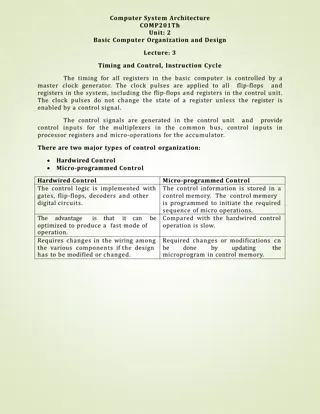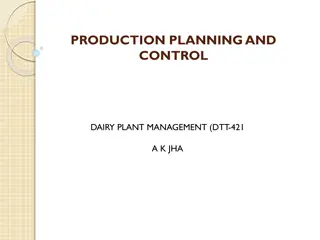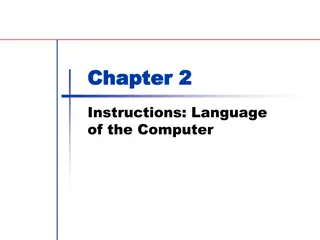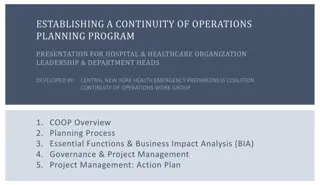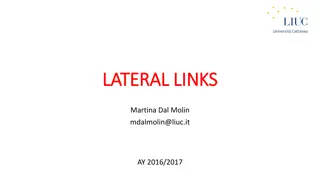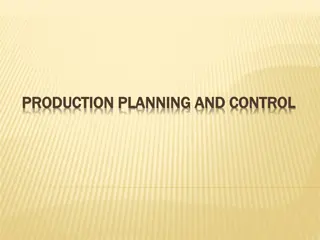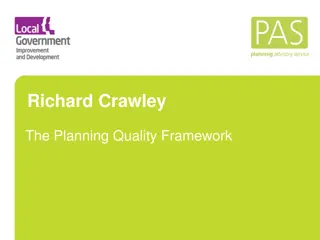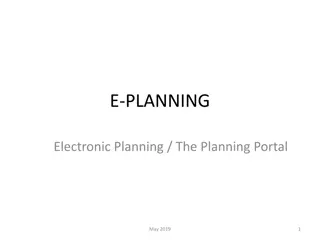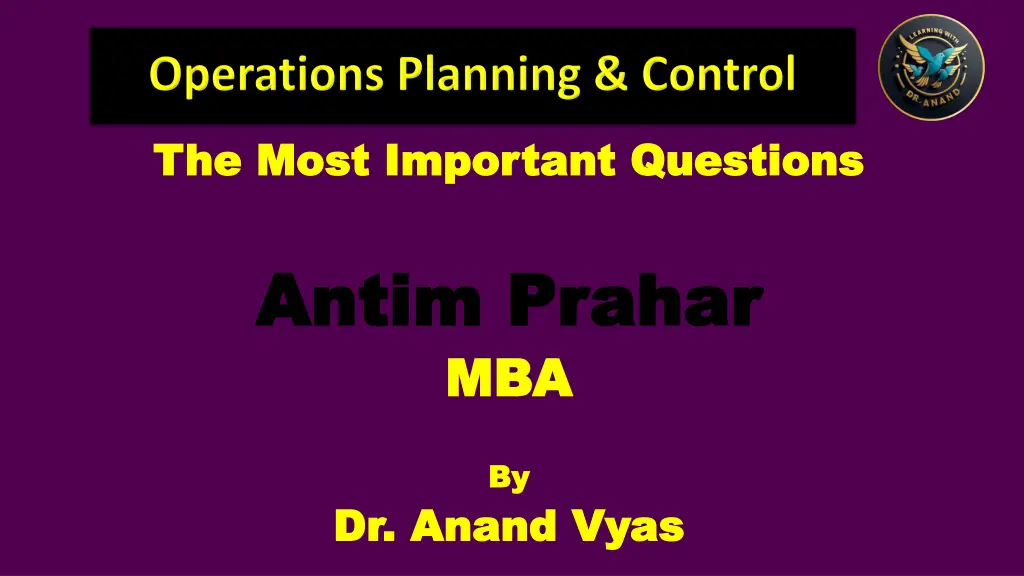
Critical Functions of PPC in Various Production Systems
Explore how Production Planning and Control (PPC) operates in different production systems like Job Shop, Batch Production, Mass Production, Continuous Production, and Cellular Manufacturing. Learn about tailored PPC strategies, optimization techniques, and efficiency-improving principles for each system.
Download Presentation

Please find below an Image/Link to download the presentation.
The content on the website is provided AS IS for your information and personal use only. It may not be sold, licensed, or shared on other websites without obtaining consent from the author. If you encounter any issues during the download, it is possible that the publisher has removed the file from their server.
You are allowed to download the files provided on this website for personal or commercial use, subject to the condition that they are used lawfully. All files are the property of their respective owners.
The content on the website is provided AS IS for your information and personal use only. It may not be sold, licensed, or shared on other websites without obtaining consent from the author.
E N D
Presentation Transcript
The Most Important Questions The Most Important Questions Antim Antim Prahar Prahar MBA MBA By By Dr. Dr. Anand Anand Vyas Vyas
1 PPC in different production Systems PPC (Production Planning and Control) is a critical function in various production systems, ensuring efficient utilization of resources and timely delivery of products. Different production systems require tailored PPC strategies to meet their specific needs. Here's how PPC operates in various production systems: Job Shop Production: In job shop production, each order is unique, and products are made to customer specifications. PPC involves scheduling jobs based on their priority, resource availability, and delivery deadlines. Critical path method (CPM) and program evaluation and review technique (PERT) are often used for scheduling. Flexibility is crucial to accommodate changes in job priorities and specifications.
Batch Production: Batch production involves manufacturing a group of similar products together in batches. PPC focuses on optimizing batch sizes, scheduling production runs, and minimizing changeover times between batches. Just-in-time (JIT) principles may be applied to reduce inventory and improve production flow. Kanban systems can help manage inventory levels and facilitate smooth material flow between workstations.
Mass Production: Mass production involves high-volume manufacturing of standardized products. PPC emphasizes continuous production flow, minimizing downtime, and maximizing throughput. Lean manufacturing principles, such as value stream mapping and 5S, are commonly employed to eliminate waste and improve efficiency. Advanced scheduling algorithms and ERP (Enterprise Resource Planning) systems are utilized for detailed production planning and resource allocation. Continuous Production: Continuous production systems operate without interruption, producing a constant flow of products. PPC focuses on maintaining optimal operating conditions, minimizing equipment downtime, and ensuring consistent product quality. Process control techniques, such as Statistical Process Control (SPC), are used to monitor and regulate production processes in real-time. Preventive maintenance schedules are implemented to reduce the risk of equipment failure and production disruptions.
Cellular Manufacturing: Cellular manufacturing organizes production into self-contained work cells, each responsible for manufacturing a specific group of products. PPC involves balancing workloads across cells, optimizing cell layouts for efficient material flow, and coordinating production schedules between cells. Cross-training of workers and multi-skilled teams may be implemented to enhance flexibility and responsiveness to changing production demands.
Materials Requirements Planning (MRP) is a set of techniques used to plan and control the inventory levels and production schedules of dependent demand items, such as components and materials required for manufacturing finished products. MRP I and MRP II are two generations of MRP systems, each offering different functionalities and levels of integration with other aspects of business operations. MRP I (Materials Requirements Planning I): MRP I primarily focuses on the planning and scheduling of material requirements based on the production schedule generated by the master production schedule (MPS). Key components of MRP I include: Bill of Materials (BOM): A hierarchical listing of all components and materials required to produce a finished product. Inventory Records: Information on current inventory levels, lead times, and reorder points for each item. Master Production Schedule (MPS): A timetable specifying the quantities of finished products to be produced over a specific time horizon. MRP I calculates the quantities and timing of orders for raw materials and components needed to support the production schedule, taking into account lead times, lot sizes, and safety stock levels. MRP I helps optimize inventory levels, reduce stockouts, and ensure timely availability of materials for production.
MRP II (Manufacturing Resource Planning II): MRP II expands upon the capabilities of MRP I by integrating additional aspects of manufacturing operations, such as capacity planning, shop floor control, and financial management. Key components of MRP II include: Capacity Planning: Assessing the availability of resources (e.g., machines, labor) to ensure that production schedules can be met. Shop Floor Control: Monitoring and controlling activities on the shop floor to ensure that production progresses according to plan. Material Requirements Planning: Similar to MRP I, but integrated with other modules for more comprehensive planning and control. Financial Management: Integrating cost data into the planning process to evaluate the financial implications of production decisions. MRP II provides a more holistic view of manufacturing operations, allowing for better coordination between production planning, resource allocation, and financial management. By considering capacity constraints and financial implications, MRP II enables more informed decision-making and improved overall performance of the manufacturing enterprise.
In summary, while MRP I focuses primarily on materials planning and inventory control, MRP II extends the scope to encompass broader aspects of manufacturing operations, including capacity planning, shop floor control, and financial management. MRP II offers greater integration and functionality, enabling organizations to achieve higher levels of efficiency and effectiveness in their manufacturing processes.
3 Enterprise Resource Planning (ERP) and Global Practices Enterprise Resource Planning (ERP) systems are comprehensive software solutions designed to integrate and streamline core business processes across an entire organization. These systems provide a centralized database and a unified platform for managing various functions, including finance, human resources, supply chain management, manufacturing, sales, and customer relationship management. implementation involve deploying ERP systems across multinational organizations to support their operations worldwide. Here are some key aspects of ERP and global practices: Standardization and Localization: ERP systems enable standardization of business processes across different locations, ensuring consistency and efficiency in operations. At the same time, global ERP implementations often require localization to accommodate regional or country-specific requirements, such as taxation laws, regulatory compliance, language, and currency. Global practices in ERP
Multi-site and Multi-currency Support: Global ERP systems organizations to manage multiple facilities or offices located in different regions or countries. They also need to handle transactions in multiple currencies, enabling seamless financial operations across international borders. Integration with Global Supply Chains: ERP systems play a crucial role in managing global supply chains by providing visibility into inventory levels, demand forecasting, supplier relationships, and logistics. Integration with suppliers, distributors, and other partners ensures smooth coordination and collaboration across the entire supply chain network. should support multi-site operations, allowing
Compliance and Risk Management: Global ERP implementations must adhere to various regulatory requirements and industry standards in different regions. ERP systems facilitate compliance management by centralizing data, automating reporting processes, and implementing internal controls to mitigate risks associated with international operations. Language and Cultural Considerations: ERP systems should support multiple languages and accommodate cultural differences to ensure effective communication and user adoption across diverse regions. Training and change management programs may need to be tailored to address cultural sensitivities and preferences. Remote Access and Mobility: With the increasing trend of remote work and distributed teams, global ERP systems should offer remote access capabilities and mobile applications to enable employees to access critical business information from anywhere, at any time. Data Security and Privacy: Global ERP implementations require robust data security measures to protect sensitive information, especially when data is transmitted across international boundaries. Compliance with data privacy regulations, such as GDPR (General Data Protection Regulation) in Europe, is essential to safeguard customer and employee data. Scalability and Flexibility: ERP systems should be scalable and flexible enough to accommodate the growth and evolving needs of multinational organizations, including mergers, acquisitions, and changes in market dynamics.
4 Aggregate Planning: Meaning, Strategies and Cost Aggregate planning is a strategic process used by businesses to determine the optimal production levels and resource allocation over a specific time horizon (usually 3 to 18 months). It involves balancing demand and capacity to meet customer requirements while minimizing costs and maximizing profitability. Here's an overview of aggregate planning, including its meaning, strategies, and cost considerations: Meaning of Aggregate Planning: Aggregate planning involves making decisions about production, inventory, staffing levels, and other resources to achieve a balance between supply and demand. The goal is to develop a feasible production plan that meets customer demand at the lowest possible cost while maintaining satisfactory levels of inventory and workforce utilization.
Strategies for Aggregate Planning: Chase Strategy: In the chase strategy, production is adjusted to match the fluctuating demand levels. Companies hire or lay off workers and adjust production levels accordingly. This strategy is suitable for industries with flexible workforce arrangements or those that can quickly adjust production capacity. Level Strategy: The level strategy maintains a steady production rate regardless of fluctuations in demand. Companies use inventory buffers and backorders to absorb variations in demand. This strategy is suitable for industries with high setup costs, long lead times, or limited workforce flexibility. Hybrid Strategy: The hybrid strategy combines elements of both the chase and level strategies. Companies use a combination of workforce adjustments, inventory management, and subcontracting to balance production and demand. This strategy offers flexibility while minimizing costs and inventory levels.
Cost Considerations in Aggregate Planning: Production Costs: Production costs include direct labor, materials, overhead expenses, and setup costs associated with changing production levels. Aggregate planning aims to minimize total production costs by optimizing resource utilization and minimizing wastage. Inventory Costs: Inventory costs include holding costs (storage, handling, insurance) and ordering costs (setup, transportation). Aggregate planning seeks to strike a balance between holding enough inventory to meet demand fluctuations and minimizing holding costs associated with excess inventory. Labor Costs: Labor costs involve hiring, training, overtime, and layoff expenses. Effective aggregate planning aims to optimize workforce utilization to minimize labor costs while meeting production requirements. Subcontracting and Outsourcing Costs: Subcontracting or outsourcing costs may be incurred when demand exceeds production capacity or specific skills are required. Aggregate planning evaluates the cost-effectiveness of subcontracting versus in-house production to meet demand fluctuations. Backorder and Stockout Costs: Backorder costs include the expenses associated with unfulfilled customer orders, such as lost sales, penalties, and customer dissatisfaction. Stockout costs arise from lost sales opportunities and damage to the company's reputation due to inadequate inventory levels. Aggregate planning aims to minimize backorder and stockout costs by ensuring adequate inventory levels or implementing alternative fulfillment strategies.
5 5S Techniques of Eliminating Wastes The 5S methodology is a systematic approach to workplace organization aimed at eliminating waste, improving efficiency, and creating a safer, more productive work environment. The 5S stands for Sort, Set in Order, Shine, Standardize, and Sustain. Each of these principles focuses on different aspects of waste reduction and organization. Here's how each of the 5S techniques helps eliminate wastes: Sort (Seiri): The first step involves sorting through all items in the workspace and identifying what is necessary (needed for current operations) and what is unnecessary (not needed or rarely used). By eliminating unnecessary items, the workspace becomes less cluttered, making it easier to find essential tools, materials, and equipment. This reduces wasted time spent searching for items and minimizes the risk of errors or accidents caused by clutter and confusion. Set in Order (Seiton): Once unnecessary items are removed, the next step is to organize the remaining items in a logical and efficient manner. Tools, materials, and equipment are arranged in designated locations based on frequency of use and workflow requirements. Visual management techniques such as labeling, color-coding, and shadow boards are used to clearly indicate where items belong and make it easy to identify when something is missing. This promotes a more organized and efficient workspace, reducing the time wasted looking for items and minimizing the risk of misplaced or lost tools.
Shine (Seiso): The shine step involves cleaning and maintaining the workspace to ensure it remains clean, safe, and free from dirt, debris, and hazards. Regular cleaning and inspection of equipment and work areas help identify and address potential issues before they become safety hazards or cause disruptions to operations. A clean and well-maintained workspace not only improves employee morale and satisfaction but also reduces the risk of accidents, equipment breakdowns, and defects. Standardize (Seiketsu): Standardization involves establishing and maintaining consistent practices and procedures for organizing, cleaning, and maintaining the workspace. Standardized work instructions, checklists, and schedules help ensure that 5S practices are followed consistently by all employees. Regular audits and performance reviews are conducted to monitor compliance with 5S standards and identify areas for improvement. Standardization fosters a culture of continuous improvement and helps sustain the gains achieved through the initial implementation of the 5S methodology. Sustain (Shitsuke): The sustain step involves creating mechanisms to sustain and reinforce the gains achieved through the 5S implementation process. This includes ongoing training and education for employees, regular audits and reviews, and recognition and rewards for maintaining 5S standards. Employee engagement and ownership are critical to sustaining the 5S culture over the long term, so efforts should be made to involve employees in the continuous improvement process and solicit their input and feedback.
6 Objective 6 Objective of Production Planning & Control, Functions of Production Planning & Control, Functions Production Planning and Control (PPC) is a crucial function within manufacturing and service industries. Its primary objective is to ensure that production operations run smoothly and efficiently while meeting the organization's overall goals and objectives. The key functions of PPC include: Demand Forecasting: This involves predicting future demand for products or services based on historical data, market trends, and other relevant factors. Accurate demand forecasting helps in planning production schedules and inventory levels. Production Planning: Once demand is forecasted, production planning involves determining what needs to be produced, when, and in what quantity. It includes creating production schedules, allocating resources, and establishing timelines for production activities.
Resource Allocation: PPC is responsible for allocating various resources such as manpower, machinery, raw materials, and finances efficiently to ensure optimal utilization and minimize waste. Inventory Management: PPC oversees inventory levels to ensure that there is neither excess nor insufficient inventory. Maintaining optimal inventory levels helps in reducing carrying costs while ensuring that customer demand can be met on time. Scheduling: This involves creating detailed schedules for production activities, including machine operation, manpower deployment, and material procurement. Scheduling aims to minimize idle time, maximize productivity, and meet delivery deadlines. Quality Control: PPC plays a role in maintaining and improving product quality standards throughout the production process. This involves implementing quality control measures, conducting inspections, and addressing any deviations from quality standards promptly.
Coordination: PPC acts as a liaison between different departments within the organization, such as sales, marketing, finance, and production. Effective coordination ensures that all departments work towards common goals and objectives. Monitoring and Control: PPC continuously monitors production processes, identifies bottlenecks or inefficiencies, and takes corrective actions to ensure that production goals are achieved within the specified time and budget constraints. Continuous Improvement: PPC is responsible for implementing continuous improvement initiatives such as Lean Manufacturing, Six Sigma, or Total Quality Management to enhance productivity, reduce costs, and improve overall efficiency in production operations. Risk Management: PPC identifies potential risks and uncertainties that may affect production operations, such as supply chain disruptions, equipment breakdowns, or changes in market demand. It develops contingency plans to mitigate these risks and ensure continuity of production.
7 Roles & Responsibilities of PPC Manager Production Planning: Develop and implement production plans to meet customer demand while optimizing resource utilization and minimizing costs. Scheduling: Create detailed production schedules, considering factors such as machine capacity, manpower availability, and material availability, to ensure timely completion of orders. Inventory Management: Monitor inventory levels of raw materials, work-in-progress, and finished goods to maintain optimal levels while minimizing holding costs and stockouts.
Demand Forecasting: Collaborate with sales and marketing teams to forecast demand for products or services accurately, facilitating proactive production planning and resource allocation. Resource Allocation: Allocate resources including manpower, machinery, and materials efficiently to meet production targets and customer delivery schedules. Quality Control: Implement quality control measures and standards to ensure that products meet quality expectations. Process Improvement: Identify opportunities for process improvement and efficiency enhancements within production operations, implementing tools and methodologies such as Lean Manufacturing or Six Sigma. Performance Monitoring: Track key performance indicators (KPIs) related to production efficiency, quality, and cost, and implement corrective actions as needed to address any deviations from targets. Communication and Coordination: Serve as a liaison between different departments such as sales, marketing, procurement, and operations to ensure alignment of production plans with overall business objectives. requirements and customer
Training and Development: Provide training and development opportunities for production staff to enhance their skills and capabilities, fostering a culture of continuous improvement and learning. Risk Management: Identify and assess risks that may impact production operations, develop contingency plans, and implement risk mitigation strategies to minimize disruptions. Budgeting and Cost Control: Prepare and manage budgets for production activities, monitor costs, and identify opportunities for cost reduction while maintaining quality standards. Compliance and Safety: Ensure compliance with regulatory requirements and safety standards in all production activities, promoting a safe and healthy work environment. Supplier Relationship Management: Collaborate with procurement teams to manage relationships with suppliers, ensuring timely delivery of materials and components required for production. Customer Satisfaction: Work closely with customer service teams to address any production-related issues or concerns raised by customers, ensuring high levels of customer satisfaction.
8 Capacity planning: Concept, Types Capacity planning is a strategic process that involves determining the production capacity needed by an organization to meet its current and future demands effectively. It aims to ensure that the organization has the right level of resources, such as machinery, equipment, labor, and facilities, to meet customer demand while balancing costs and efficiency. Capacity planning involves forecasting demand, evaluating existing capacity, and making adjustments to match capacity with demand. Types of Capacity Planning: Strategic Capacity Planning: Long-term planning focused on major capital investments and changes in production processes. Involves decisions regarding the expansion or contraction of facilities, introduction of new technologies, or changes in production methods. Aimed at aligning capacity with long-term business goals and market trends.
Tactical Capacity Planning: Medium-term planning typically covering a period of months to a few years. Focuses on adjustments to existing capacity to meet fluctuating demand. Involves decisions regarding hiring or layoffs, subcontracting, overtime, and temporary labor. Aims to optimize the utilization of existing resources and maintain a balance between capacity and demand. Operational Capacity Planning: Short-term planning covering days to weeks. Focuses on day-to-day scheduling and allocation of resources to meet immediate production requirements. Involves decisions regarding shift scheduling, machine utilization, and material handling. Aims to ensure smooth production flow and minimize disruptions.
Lead Time Capacity Planning: Planning focused on the time required to increase or decrease capacity. Involves estimating the lead time for acquiring additional resources, such as machinery or labor, to meet changing demand. Helps in determining the responsiveness of the organization to fluctuations in demand and adjusting capacity accordingly. Resource Capacity Planning: Planning focused on specific resources, such as manpower, machinery, or raw materials. Involves assessing the availability and capability of each resource to determine overall capacity. Helps in identifying potential bottlenecks and constraints in production processes.
9 Loading: Process and Strategies Loading, in the context of manufacturing planning, refers to the allocation of work or production tasks to the various processes necessary for manufacturing each item. It is a crucial step in Capacity Requirements Planning (CRP), which ensures that the available resources are utilized efficiently to meet production demands. Here's an explanation of the loading process and strategies involved: Process Exploration (Process Explosion): Before loading can occur, each item planned in Material Requirements Planning (MRP) is analyzed to identify the processes required for its manufacture. This process explosion manufacturing process into its constituent operations or tasks. involves breaking down the
Loading: Process and Strategies Loading: Process and Strategies Definition of Loading: Loading refers to the process of assigning work to resources such as machines, labor, or work centers in a manufacturing or service environment. The objective is to ensure that the resources are utilized efficiently while meeting production schedules, minimizing costs, and achieving desired output levels.
Process of Loading Process of Loading The process of loading typically involves the following steps: Identification of Work Requirements: Determine the workload based on production schedules or service demand. Break down tasks into smaller operations that can be assigned to resources. Assessment of Resource Availability: Evaluate the capacity of machines, workforce, and work centers. Check for constraints such as maintenance schedules, skill levels, and working hours. Allocation of Tasks: Distribute tasks among available resources based on their capability and availability. Prioritize tasks based on deadlines, importance, or customer demand. Balancing Workloads: Ensure that no resource is overburdened or underutilized. Adjust workloads dynamically to avoid bottlenecks or idle time. Monitoring and Adjustments: Continuously track resource utilization and task progress. Make adjustments to the loading plan in response to changes in demand or unforeseen issues.
Strategies for Loading Strategies for Loading The strategies for loading can be broadly categorized into infinite loading and finite loading: 1. Infinite Loading: Concept: Assigns work to resources without considering their actual capacity. The assumption is that resources are unlimited and can handle any amount of work. 2. Finite Loading: Concept: Allocates work to resources based on their actual capacity. Ensures that the assigned tasks do not exceed the available resources.
Loading: Once the processes necessary for manufacturing each item are identified, the loading process begins. Loading involves allocating the necessary work or tasks to the available processes in a way that optimizes resource utilization and minimizes idle time. Loading is typically performed by time intervals, often in hourly increments. Each hour represents a unit of time during which the process is allocated work. During loading, setup times and real operating times are considered. Setup time refers to the time required to prepare a process for operation, while real operating time refers to the time required to actually perform the manufacturing tasks. The real operating time may be determined based on manufacturing lots or by the time required per item unit. In the former case, the time is allocated based on the size of the production batch, while in the latter case, the time is allocated based on the production rate per item.
10 Capacity Planning Strategies Capacity Planning Strategies Load is the amount of work that MUST be done, amount of work scheduled ahead of a manufacturing facility. Capacity is the amount of work that CAN be done, and measures the highest output of work expressed as a rate with current product specifications, work force, plant, equipment etc.
Capacity planning is crucial for ensuring that an organization's resources are aligned with its production demands. Here are five capacity planning strategies: Lead Strategy: The lead strategy involves making proactive investments in capacity well in advance of anticipated demand increases. Organizations employing this strategy invest in expanding facilities, acquiring new equipment, or hiring additional staff ahead of time to accommodate future growth. This strategy allows organizations to avoid capacity constraints and ensures they can meet increasing demand without disruptions. Lag Strategy: The lag strategy involves delaying capacity expansion until demand exceeds current capacity. Organizations employing this strategy prioritize cost efficiency and risk mitigation by waiting to invest in additional capacity until it becomes necessary. While this strategy minimizes the risk of overinvestment, it can lead to capacity constraints and potential customer dissatisfaction during periods of high demand.
Match Strategy: The match strategy aims to align capacity expansion closely with changes in demand. Organizations employing this strategy invest in capacity expansion in response to changes in demand, ensuring that capacity matches current and future requirements closely. This strategy balances the risks associated with overinvestment and underinvestment, allowing organizations to maintain flexibility while meeting demand effectively. Buffer Strategy: The buffer strategy involves maintaining excess capacity or buffer inventory to absorb fluctuations in demand. Organizations employing this strategy deliberately maintain a cushion of excess capacity or inventory to accommodate variability in demand without the need for immediate capacity adjustments. While this strategy increases resilience to demand fluctuations, it can lead to higher carrying costs and reduced efficiency if excess capacity or inventory remains unused for extended periods. Hybrid Strategy: The hybrid strategy combines elements of the lead, lag, match, or buffer strategies to tailor capacity planning to the specific needs of the organization. Organizations employing this strategy may use different capacity planning approaches for different products, markets, or stages of the product lifecycle. This strategy offers flexibility and adaptability, allowing organizations to optimize capacity planning based on changing market conditions, customer demands, and internal capabilities.
11 Role of control rooms in Production plants (Bar and Gantt Charts) Control rooms play a central role in production plants by serving as command centers where operators and engineers monitor and control various aspects of the manufacturing process. The primary functions and roles of control rooms in production plants include: Monitoring Production Processes: Control rooms are equipped with instrumentation and monitoring systems that provide real- time data on key process variables such as temperature, pressure, flow rates, and equipment status. Operators continuously monitor these parameters to ensure that production processes are running smoothly and within specified operating limits. Control and Regulation: Control rooms enable operators to adjust process parameters and control equipment remotely to maintain optimal operating conditions. Automated control systems, such as distributed control systems (DCS) or supervisory control and data acquisition (SCADA) systems, allow for precise regulation of process variables to meet production targets and quality standards.
Safety and Emergency Response: Control rooms are equipped with alarm systems and emergency shutdown controls to detect abnormal conditions or safety hazards. Operators can quickly respond to alarms, initiate emergency procedures, and shut down equipment if necessary to prevent accidents or mitigate risks to personnel and equipment. Optimization and Efficiency: Control rooms play a key role in optimizing production efficiency by identifying opportunities for process improvements and implementing changes to enhance productivity. Operators analyze production data, identify bottlenecks or inefficiencies, and implement corrective actions to maximize throughput and minimize downtime.
Bar charts and Gantt charts are both types of graphical tools used in project management to visualize project schedules and timelines. While they have similarities, they serve different purposes and have distinct characteristics: Bar Chart: Purpose: Bar charts, also known as a "bar graph" or "bar diagram," are used to represent data in a graphical format using rectangular bars. In project management, bar charts are commonly used to display activities or tasks along with their start and end dates. Appearance: In a bar chart, each bar represents a specific task or activity, and the length of the bar corresponds to the duration of the task. The bars are typically arranged horizontally or vertically along a time axis. Features: Each bar is positioned at the start date of the corresponding task and extends to the end date. Bar charts are simple and easy to understand, making them useful for presenting project schedules to stakeholders. They do not typically show dependencies between tasks or the sequence in which tasks need to be performed.
Gantt Chart: Purpose: Gantt charts are a type of bar chart specifically designed for project management. They provide a visual representation of a project schedule, including task durations, dependencies, and the overall project timeline. Appearance: In a Gantt chart, tasks are represented by horizontal bars positioned along a timeline. The length of each bar indicates the duration of the task, while the positioning of the bars shows the start and end dates. Dependencies between tasks are indicated by linking the bars with arrows.
12 Product Control Systems and strategies for corrective actions Product control systems are processes and mechanisms implemented by organizations to ensure the quality, consistency, and conformity of their products or services. These systems help monitor and manage various aspects of production, from raw material procurement to final product delivery, to meet customer requirements and regulatory standards. Corrective actions are strategies employed to address deviations or non-conformities identified within the product control system. Here are some common product control systems and strategies for corrective actions: Quality Management Systems (QMS): QMS, such as ISO 9001, provide a framework for establishing and maintaining quality control processes throughout the organization. Corrective actions within a QMS typically involve identifying root causes of quality issues, implementing corrective measures, and monitoring effectiveness through performance metrics and audits. Statistical Process Control (SPC): SPC involves monitoring and controlling production processes through statistical techniques to ensure they operate within specified quality parameters. Corrective actions in SPC may include adjusting process parameters, re-calibrating equipment, or conducting root cause analysis to identify and eliminate sources of variation.
Failure Mode and Effects Analysis (FMEA): FMEA is a proactive risk management tool used to identify potential failure modes in products or processes and assess their potential impact. Corrective actions in FMEA involve prioritizing and addressing high-risk failure modes through preventive measures or process improvements. Six Sigma: Six Sigma is a data-driven methodology aimed at reducing defects and improving process efficiency by systematically eliminating variation. Corrective actions in Six Sigma involve applying DMAIC (Define, Measure, Analyze, Improve, Control) methodology to identify root causes of defects, implement process improvements, and verify their effectiveness. Total Quality Management (TQM): TQM is a holistic approach to quality management that emphasizes continuous improvement, customer focus, and employee involvement. Corrective actions in TQM involve empowering employees to identify and address quality issues, implementing process improvements, and fostering a culture of continuous learning and innovation.
Supplier Quality Management: Supplier quality management systems ensure that suppliers meet quality standards and deliver materials or components that meet specifications. Corrective actions with suppliers may include conducting supplier audits, providing feedback on non-conformities, and collaborating to implement corrective and preventive measures. Customer Feedback and Complaint Handling: Systems for collecting and analyzing customer feedback and complaints are essential for identifying product quality issues and opportunities for improvement. Corrective actions based on customer feedback may involve issuing product recalls, implementing design changes, or improving customer service processes. Product Lifecycle Management (PLM): PLM systems help manage the entire lifecycle of a product, from concept development to end-of-life disposal. Corrective actions in PLM may involve revising product specifications, updating documentation, or implementing design changes based on feedback from testing and usage data.
13 Types of waste and Lean process to minimize wastages Types of waste Liquid Waste: Consists of dirty water, organic liquids, wash water, and rainwater. Classified as point source or non-point source waste. Solid Rubbish: Includes plastic waste, paper/card waste, tins and metals, ceramics and glass. These items can often be recycled. Organic Waste: Comprises food waste, garden waste, manure, and rotten meat. Should be disposed of properly to avoid methane production in landfills.
Recyclable Rubbish: Includes items like paper, metals, furniture, and organic waste that can be converted into reusable products. Hazardous Waste: Contains flammable, toxic, corrosive, and reactive materials that can harm humans and the environment. Requires proper disposal methods, often through waste removal companies.
Lean methodology provides a systematic approach to minimize wastages across various processes within an organization. Here's an overview of key Lean processes commonly used to minimize waste: Value Stream Mapping (VSM): Value stream mapping is a visual tool used to analyze and improve the flow of materials and information through a process. By mapping out the current state of a process and identifying value-added and non- value-added activities, organizations can pinpoint areas of waste and inefficiency. Lean practitioners then develop future state maps to design optimized processes that minimize waste and improve overall efficiency. 5S Methodology: 5S is a workplace organization technique focused on creating a clean, organized, and efficient work environment. The five S's stand for Sort, Set in Order, Shine, Standardize, and Sustain. By systematically implementing these principles, organizations can reduce waste related to unnecessary movement, waiting, and searching for tools or materials.
Just-in-Time (JIT) Production: JIT production aims to produce goods or services exactly when they are needed, in the quantity required, and without excess inventory. By synchronizing production with customer demand, organizations can minimize waste related to overproduction, excess inventory, and transportation. Kaizen (Continuous Improvement): Kaizen involves continuously identifying and implementing small incremental improvements to processes, systems, and workflows. Through employee involvement and empowerment, organizations can systematically eliminate waste and drive continuous improvement across all aspects of their operations. Total Productive Maintenance (TPM): TPM focuses on maximizing equipment effectiveness and reliability to eliminate downtime, defects, and breakdowns. By implementing proactive maintenance practices and involving operators in equipment maintenance activities, organizations can minimize waste related to unplanned downtime, defects, and overprocessing. Poka-Yoke (Error-Proofing): Poka-Yoke involves designing processes or systems in a way that prevents errors from occurring or detects them before they result in defects or waste. By implementing mistake-proofing techniques such as visual cues, checklists, and automated controls, organizations can minimize waste related to defects, rework, and overprocessing.
14 Master production Scheduling The Master Production Schedule (MPS) is a crucial planning tool in manufacturing operations that helps synchronize production with customer demand and available resources. Here's a summary of the key points about MPS: Purpose and Importance: The MPS outlines the schedule for completing end items and serves as a linkage between planning processes. It provides information on the quantity and timing of production for individual end items over a planning horizon. MPS aids in planning responses to market demands and provides essential information for production, planning, purchasing, and top management. Role in Balancing Demand and Supply: MPS helps balance customer demand with the factory's capacity and supplier capabilities. It determines the number of items to be produced and planned inventories of raw materials, finished products, and parts.
Inputs and Outputs: Inputs for creating an MPS include customer orders, production plans from aggregate planning, forecasts, available resources, inventory levels, and capacity constraints. Outputs of MPS include production quantities, due dates, available-to- promise quantities, and projected available balances. Nature of MPS: MPS focuses on end items and does not act as a sales forecast, manufacturing schedule, wish list, or final assembly schedule. It does not involve detailed planning for parts or components, which are addressed in subsequent planning stages. Steps in Creating an MPS: Forming a preliminary MPS based on input data and forecasts. Performing rough-cut capacity planning to ensure production capacity aligns with the schedule. Resolving any discrepancies or conflicts in the MPS to create a finalized production plan.






